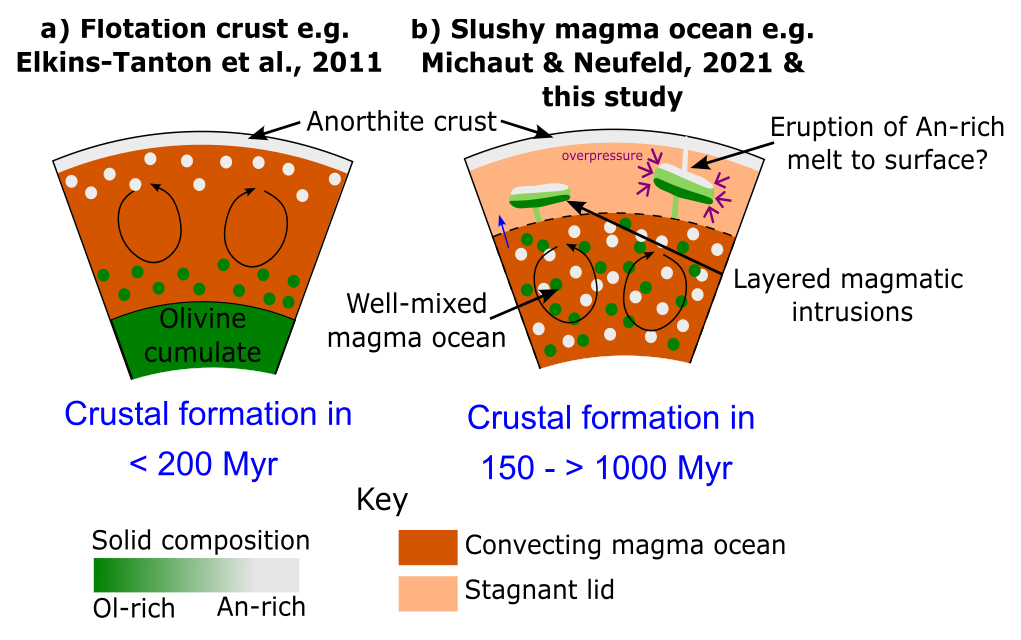Lunar crustal formation by melt migration and differentiation within a stagnant lid.
- 1LGL-TPE, École Normale Supérieure de Lyon, 46 Allée d’Italie, Lyon, 69007, France.
- 2Department of Applied Mathematics and Theoretical Physics, Centre for Mathematical Sciences, University of Cambridge, Wilberforce Road, Cambridge, CB3 0WA, UK.
- 3Institute for Energy and Environmental Flows, University of Cambridge, Madingley Road, Cambridge, CB3 0EZ, UK.
The lunar anorthosite highlands, composed of 90 wt% anorthite (Ca-rich plagioclase), represent the Moon’s primary crust [1], which formed during the solidification of a magma ocean following the Moon-forming giant impact between the proto-Earth and Theia. The composition of this anorthite-enriched crust is unique among the terrestrial bodies within our Solar System and can be easily reproduced by crustal formation due to the flotation of buoyant anorthite crystals during magma ocean solidification [2] (Fig. 1a). However, this canonical model often struggles to reproduce the long, > 200 Myr solidification timescale required by the ages of the anorthosite suite [2], as well as the diverse magmatic histories of the lunar anorthosites [3].
If, instead, the anorthite crystals remain entrained in magma ocean due to vigorous convection, the magma ocean behaves as a liquid-crystal slurry with an immobile stagnant lid at the surface (Fig. 1b), which reduces the cooling rate of the magma ocean and results in long solidification durations [3]. In this regime, crustal formation occurs via extraction of melt from the magma ocean through the stagnant lid. In this study, we investigate whether sufficient magmatic differentiation can occur within the stagnant lid to produce an anorthite-rich crust. Our model consists of a simplified two-component anorthite-olivine melt system, which becomes progressively enriched in anorthite as the melt solidifies. We calculate the thermochemical evolution of this melt as it rises through a growing stagnant lid, cools, and solidifies for a range of Peclet numbers (the ratio of the rate of advection to diffusion), and lid thicknesses.
We find that for low Peclet numbers (<1), little differentiation and melt accumulation occurs within the lid, regardless of lid thickness, and no anorthosite crust formation is likely possible. On the other hand, for the high Peclet numbers relevant to the lunar magma ocean (>30), thick, melt- and anorthite-rich (>30 vol%) sills can form within the lid and migrate slowly upwards. However, the composition of these sills is still more olivine-rich than that observed in the lunar highlands. Therefore, further differentiation is likely required within the sills themselves. This could occur by the flotation of anorthite crystals as this is a process that is more likely to occur in these emplaced magmatic bodies than at the scale of the magma ocean. Equally none of these sills are predicted to reach the cold, solid surface of the lid. However, we find that the overpressure within the sills is sufficient to drive the eruption of this melt to the surface, leading to a crustal formation by a combination of extrusive and intrusive magmatism.
[1] Wood et al., 1970, in Proceedings of the Apollo 11 Lunar Science Conference (pp. 1965-1988)
[2] Elkins-Tanton, L.T., Burgess, S. and Yin, Q.Z., 2011. The lunar magma ocean: Reconciling the solidification process with lunar petrology and geochronology. Earth and Planetary Science Letters, 304(3-4), pp.326-336.
[3] Ashwal, L.D. and Bybee, G.M., 2017. Crustal evolution and the temporality of anorthosites. Earth-Science Reviews, 173, pp.307-330.
[4] Michaut, C. and Neufeld, J.A., 2022. Formation of the lunar primary crust from a long‐lived slushy magma ocean. Geophysical Research Letters, 49(2), p.e2021GL095408.

Fig. 1. Sketches of a) the classical anorthite flotation crust model and b) the slushy magma ocean model where the crystal fraction remains entrained by convection and a crust forms by melt extraction in a stagnant lid.
How to cite: Dodds, K., Michaut, C., and Neufeld, J.: Lunar crustal formation by melt migration and differentiation within a stagnant lid., Europlanet Science Congress 2024, Berlin, Germany, 8–13 Sep 2024, EPSC2024-870, https://doi.org/10.5194/epsc2024-870, 2024.